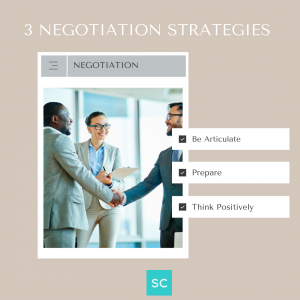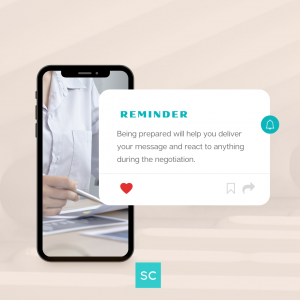3 Negotiation Strategies
There are many times during your career when you may need to utilize a negotiation strategy. You could be negotiating for a higher salary, motivating a team, or winning a new client with your offer suite. Having a plan will help you get your preferred outcome wherever you find yourself.
The key to negotiation is communication. This is because when you can clearly present your ideas to others, they are much more likely to be persuaded by you.
Below are 3 negotiation strategies that we believe will help you advance throughout your career.
1. Be Articulate
Being articulate means, you can speak clearly and concisely. Your ideas are easily understood when you are articulate, which is an important part of the negotiation process.
To be more articulate, consider the following:
- Filler Words – Filler words distract from your point. Words like um, uh, ah, and like, make it much more difficult for people to understand what you are trying to convey. For example, consider how not using filler words is a more direct way of stating your message in the following two options:
Option #1 – I should get a raise based on several factors. First, I have taken on more responsibility in the last three months. Second, I am leading two additional team members. And third, my productivity has increased by 25%.
Option #2 – So, uh, like, you know, I believe I should get a raise, um because, um well, there are a lot of um, reasons. First, I uh, have, you know, have taken on more responsibility kind of. Second, I um, you know, like leading two additional team members. And um, third, my uh, productivity has increased by 25%.
The second option may be a bit of an exaggeration. Still, you can see how filler words make it more challenging to understand what you are saying and come across as very unprofessional.
- Your Flow – Your flow is how easily you can deliver your message. When you focus on your flow, you eliminate run-on sentences, tangents, and make sure everything you say makes logical sense. For example, telling a story that doesn’t relate, or the point is unclear is a tangent you’ll want to avoid. During a negotiation, everything you say should directly connect to the point you are trying to make.

- Confidence – When it comes to being more articulate, the more confident you are, your message will have more authority. For example, confident communication is clear, which means you aren’t mumbling as you speak. Confident communication also means you know how to pronounce all of the words you say, and you’ve practiced enough to feel comfortable speaking. The more confident you are when you speak, the more impact your message has.
Being articulate will help you communicate your ideas to others so they can see the value in them.
2. Prepare
Any negotiation requires you to prepare. The more knowledge you have about the other person, the company, and your reasons, the better position you will be in to negotiate.
As you prepare, consider the following:
- Research – When you begin to prepare for a negotiation, research is paramount. For example, if you hope to land a new client, you must first know who they were working with before. You will want to determine how much their previous contract was for, and what deliverables were included. This way, when you go to the negotiation table, you have something to work off of. You can show the client how you can beat the previous contract and deliver more for less. The research will help you prepare for the negotiation.

- Practice – Knowing what you will say will help you feel confident as you say it. Practicing will give you this confidence. There are many ways to practice; you can ask a friend to listen to you and give feedback. You can also role-play to help you prepare for anything the other person may say. The more you practice, the more prepared you will be.
- Best + Worst Case – Part of preparing is working out the best and worst-case outcomes of your negotiation. For example, if the worst-case scenario is the client doesn’t go for your offer, you can use this as an opportunity to reevaluate your terms. If landing the client is the most important thing to your company, you may want to consider lowering your fees or offering more deliverables at the same cost. On the flip side, thinking about what you will do if the best-case scenario happens is also part of your preparation. This is because if the client does decide to sign with you, there are several departments this may impact. Knowing what you will need to do next will help ensure things run smoothly.
Being prepared will help you deliver your message and react to anything during the negotiation.
3. Think Positively
When you enter a negotiation situation, you need to think positively. This is because your tone of voice and body language will let the other party know whether or not you believe in what you are saying without speaking a word.
As you prepare, consider the following:
- Tone Of Voice – Your tone of voice will help make your message impactful. Your tone needs to be intentional and match the energy of your message. If you are thinking positively, your tone will reflect that; however, if you aren’t, your tone will show you don’t believe in your message. For example, if you ask for a raise and your tone is defeated or questioned, your boss may feel like you don’t even believe you deserve a raise. However, if your tone is upbeat and confident, your boss will think you deserve this raise.
- Body Language – Your body language can tell the other party whether you believe in what you are saying or not. For example, if you come to the negotiation table with your shoulders slumped and your head down with minimal eye contact, your body language shows others you don’t believe in your message. However, if you come to the negotiation table with your head held high, shoulders back, and good eye contact, the other party will already know you believe in your message and are confident about what you are saying. Your body language will reflect what you think.
- Remove Mental Barriers – Mental barriers are negative thoughts that stem from experiences you’ve had. To think positively, you have to remove mental barriers. For example, let’s say you’ve asked for a raise in the past and were rejected. This may make you create a mental barrier in your head, telling you that you will never get a raise. However, this isn’t true! Once you’ve identified the mental barrier, you can reframe it. Perhaps you weren’t given a raise in the past, but today is a different day. You have grown, and you deserve this raise. Taking power away from the mental barrier will help you remove it and think positively.
Thinking positively will help you walk into the negotiation with confidence.
Negotiations are part of the workplace. Communicating with confidence will help you get the outcome you are looking for.
__
Whenever you’re ready, there are 3 ways we can help you:
- Discover your communications style so you know where to start. Over 4,000 people have found theirs here.
- Attend our monthly communication workshop to build communications confidence (new topics: public speaking, advocating for yourself, building credibility, etc) here.
- Get your brand in front of 43k+ people by sponsoring our newsletter or Soulcast Media | LIVE LinkedIn events [contact: hello@soulcastmedia.com]











